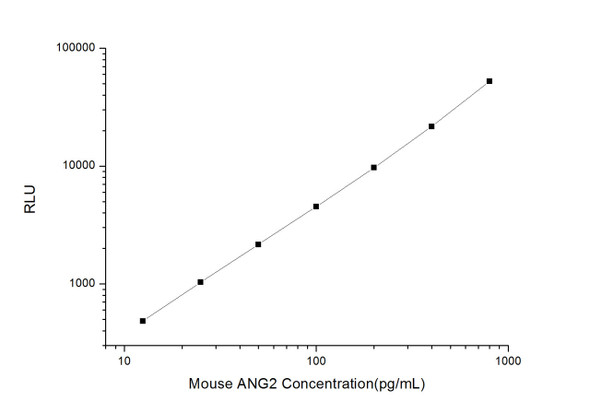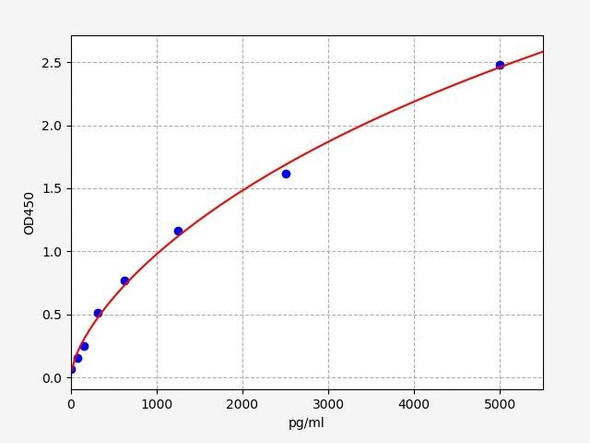Rat Signaling ELISA Kits 2
Rat ANG2 (Angiopoietin 2) CLIA Kit (RTES00073)
- SKU:
- RTES00073
- Product Type:
- ELISA Kit
- ELISA Type:
- CLIA Kit
- Size:
- 96 Assays
- Sensitivity:
- 9.38pg/mL
- Range:
- 15.63-1000pg/mL
- ELISA Type:
- Sandwich
- Synonyms:
- ANGPT2, AGPT2
- Reactivity:
- Rat
- Sample Type:
- Serum, plasma and other biological fluids
- Research Area:
- Cardiovascular
Description
| Assay type: | Sandwich |
| Format: | 96T |
| Assay time: | 4.5h |
| Reactivity: | Rat |
| Detection method: | Chemiluminescence |
| Detection range: | 15.63-1000 pg/mL |
| Sensitivity: | 9.38 pg/mL |
| Sample volume: | 100µL |
| Sample type: | Serum, plasma and other biological fluids |
| Repeatability: | CV < 15% |
| Specificity: | This kit recognizes Rat ANG2 in samples. No significant cross-reactivity or interference between Rat ANG2 and analogues was observed. |
This kit uses Sandwich-CLIA as the method. The micro CLIA plate provided in this kit has been pre-coated with an antibody specific to Rat ANG2. Standards or samples are added to the appropriate micro CLIA plate wells and combined with the specific antibody. Then a biotinylated detection antibody specific for Rat ANG2 and Avidin-Horseradish Peroxidase (HRP) conjugate are added to each micro plate well successively and incubated. Free components are washed away. The substrate solution is added to each well. Only those wells that contain Rat ANG2, biotinylated detection antibody and Avidin-HRP conjugate will appear fluorescence. The Relative light unit (RLU) value is measured spectrophotometrically by the Chemiluminescence immunoassay analyzer. The RLU value is positively associated with the concentration of Rat ANG2. The concentration of Rat ANG2 in the samples can be calculated by comparing the RLU of the samples to the standard curve.
| UniProt Protein Function: | ANGPT2: Binds to TEK/TIE2, competing for the ANGPT1 binding site, and modulating ANGPT1 signaling. Can induce tyrosine phosphorylation of TEK/TIE2 in the absence of ANGPT1. In the absence of angiogenic inducers, such as VEGF, ANGPT2-mediated loosening of cell-matrix contacts may induce endothelial cell apoptosis with consequent vascular regression. In concert with VEGF, it may facilitate endothelial cell migration and proliferation, thus serving as a permissive angiogenic signal. Interacts with TEK/TIE2, competing for the same binding site as ANGPT1. 3 isoforms of the human protein are produced by alternative splicing. |
| UniProt Protein Details: | Protein type:Secreted, signal peptide; Secreted Chromosomal Location of Human Ortholog: 8p23. 1 Cellular Component: extracellular space; cell projection; extracellular region; plasma membrane; nucleus Molecular Function:protein binding; metal ion binding; receptor tyrosine kinase binding; receptor binding Biological Process: Tie receptor signaling pathway; organ regeneration; maternal process involved in pregnancy; negative regulation of blood vessel endothelial cell migration; signal transduction; response to organic cyclic substance; germ cell development; negative regulation of positive chemotaxis; response to radiation; negative regulation of angiogenesis; positive regulation of angiogenesis; response to mechanical stimulus; response to hypoxia; response to glucose stimulus; response to activity; angiogenesis; blood coagulation; leukocyte migration |
| NCBI Summary: | The protein encoded by this gene is an antagonist of angiopoietin 1 (ANGPT1) and endothelial TEK tyrosine kinase (TIE-2, TEK). The encoded protein disrupts the vascular remodeling ability of ANGPT1 and may induce endothelial cell apoptosis. Three transcript variants encoding three different isoforms have been found for this gene. [provided by RefSeq, Jul 2008] |
| UniProt Code: | O35462 |
| NCBI GenInfo Identifier: | 169646754 |
| NCBI Gene ID: | 285 |
| NCBI Accession: | NP_001112360. 1 |
| UniProt Secondary Accession: | O35462,O35608, O35462, |
| UniProt Related Accession: | O15123 |
| Molecular Weight: | |
| NCBI Full Name: | angiopoietin-2 isoform c |
| NCBI Synonym Full Names: | angiopoietin 2 |
| NCBI Official Symbol: | ANGPT2 |
| NCBI Official Synonym Symbols: | ANG2; AGPT2 |
| NCBI Protein Information: | angiopoietin-2 |
| UniProt Protein Name: | Angiopoietin-2 |
| UniProt Gene Name: | ANGPT2 |
| UniProt Entry Name: | ANGP2_HUMAN |
As the RLU values of the standard curve may vary according to the conditions of the actual assay performance (e. g. operator, pipetting technique, washing technique or temperature effects), the operator should establish a standard curve for each test. Typical standard curve and data is provided below for reference only.
| Concentration (pg/mL) | RLU | Average | Corrected |
| 1000 | 49400 57950 | 53675 | 53650 |
| 500 | 21243 23735 | 22489 | 22464 |
| 250 | 10317 10105 | 10211 | 10186 |
| 125 | 4802 5000 | 4901 | 4876 |
| 62.5 | 2649 2257 | 2453 | 2428 |
| 31.25 | 1377 1185 | 1281 | 1256 |
| 15.63 | 686 730 | 708 | 683 |
| 0 | 25 25 | 25 | -- |
Precision
Intra-assay Precision (Precision within an assay): 3 samples with low, mid range and high level Rat ANG2 were tested 20 times on one plate, respectively.
Inter-assay Precision (Precision between assays): 3 samples with low, mid range and high level Rat ANG2 were tested on 3 different plates, 20 replicates in each plate.
| Intra-assay Precision | Inter-assay Precision | |||||
| Sample | 1 | 2 | 3 | 1 | 2 | 3 |
| n | 20 | 20 | 20 | 20 | 20 | 20 |
| Mean (pg/mL) | 52.22 | 123.32 | 456.70 | 53.68 | 121.62 | 435.90 |
| Standard deviation | 6.43 | 14.02 | 40.19 | 4.98 | 10.50 | 43.98 |
| C V (%) | 12.31 | 11.37 | 8.80 | 9.28 | 8.63 | 10.09 |
Recovery
The recovery of Rat ANG2 spiked at three different levels in samples throughout the range of the assay was evaluated in various matrices.
| Sample Type | Range (%) | Average Recovery (%) |
| Serum (n=5) | 92-107 | 99 |
| EDTA plasma (n=5) | 97-114 | 104 |
| Cell culture media (n=5) | 91-107 | 98 |
Linearity
Samples were spiked with high concentrations of Rat ANG2 and diluted with Reference Standard & Sample Diluent to produce samples with values within the range of the assay.
| Serum (n=5) | EDTA plasma (n=5) | Cell culture media (n=5) | ||
| 1:2 | Range (%) | 102-118 | 95-109 | 93-108 |
| Average (%) | 109 | 103 | 99 | |
| 1:4 | Range (%) | 87-103 | 90-104 | 85-98 |
| Average (%) | 94 | 95 | 90 | |
| 1:8 | Range (%) | 95-110 | 90-102 | 90-103 |
| Average (%) | 101 | 96 | 96 | |
| 1:16 | Range (%) | 103-116 | 92-107 | 103-120 |
| Average (%) | 109 | 100 | 109 |
An unopened kit can be stored at 4°C for 1 month. If the kit is not used within 1 month, store the items separately according to the following conditions once the kit is received.
| Item | Specifications | Storage |
| Micro CLIA Plate(Dismountable) | 8 wells ×12 strips | -20°C, 6 months |
| Reference Standard | 2 vials | |
| Concentrated Biotinylated Detection Ab (100×) | 1 vial, 120 µL | |
| Concentrated HRP Conjugate (100×) | 1 vial, 120 µL | -20°C(shading light), 6 months |
| Reference Standard & Sample Diluent | 1 vial, 20 mL | 4°C, 6 months |
| Biotinylated Detection Ab Diluent | 1 vial, 14 mL | |
| HRP Conjugate Diluent | 1 vial, 14 mL | |
| Concentrated Wash Buffer (25×) | 1 vial, 30 mL | |
| Substrate Reagent A | 1 vial, 5 mL | 4°C (shading light) |
| Substrate Reagent B | 1 vial, 5 mL | 4°C (shading light) |
| Plate Sealer | 5 pieces | |
| Product Description | 1 copy | |
| Certificate of Analysis | 1 copy |
- Set standard, test sample and control (zero) wells on the pre-coated plate and record theirpositions. It is recommended to measure each standard and sample in duplicate. Note: addall solutions to the bottom of the plate wells while avoiding contact with the well walls. Ensuresolutions do not foam when adding to the wells.
- Aliquot 100µl of standard solutions into the standard wells.
- Add 100µl of Sample / Standard dilution buffer into the control (zero) well.
- Add 100µl of properly diluted sample (serum, plasma, tissue homogenates and otherbiological fluids. ) into test sample wells.
- Cover the plate with the sealer provided in the kit and incubate for 90 min at 37°C.
- Aspirate the liquid from each well, do not wash. Immediately add 100µL of BiotinylatedDetection Ab working solution to each well. Cover the plate with a plate seal and gently mix. Incubate for 1 hour at 37°C.
- Aspirate or decant the solution from the plate and add 350µL of wash buffer to each welland incubate for 1-2 minutes at room temperature. Aspirate the solution from each well andclap the plate on absorbent filter paper to dry. Repeat this process 3 times. Note: a microplatewasher can be used in this step and other wash steps.
- Add 100µL of HRP Conjugate working solution to each well. Cover with a plate seal andincubate for 30 min at 37°C.
- Aspirate or decant the solution from each well. Repeat the wash process for five times asconducted in step 7.
- Add 100µL of Substrate mixture solution to each well. Cover with a new plate seal andincubate for no more than 5 min at 37°C. Protect the plate from light.
- Determine the RLU value of each well immediately.






